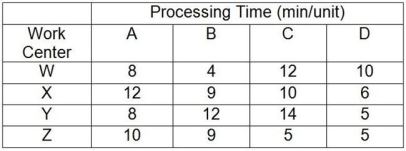Table 5.2
A company makes four products that have the following characteristics: Product A sells for $75 but needs $20 of materials and $20 of labor to produce; Product B sells for $90 but needs $45 of materials and $20 of labor to produce; Product C sells for $110 but needs $50 of materials and $30 of labor to produce; Product D sells for $135 but needs $75 of materials and $40 of labor to produce. The processing requirements for each product on each of the four machines are shown in the table.

Work centers W, X, Y, and Z are available for 40 hours per week and have no setup time when switching between products. Market demand is 50 As, 60 Bs, 70 Cs, and 80 Ds per week. In the questions that follow, the traditional method refers to maximizing the contribution margin per unit for each product, and the bottleneck method refers to maximizing the contribution margin per minute at the bottleneck for each product.
-Use the information in Table 5.2. Using the bottleneck method, in what sequence should products be scheduled for production?
Definitions:
Total Amount
The complete sum of money required or received, often including principal, interest, taxes, and fees.
Ordinary Interest
Interest calculated on the basis of a 360-day year, which is commonly used in calculating interest for loans, mortgages, and bonds.
360-Day Year
An accounting method that simplifies interest calculation by assuming all months have 30 days, resulting in a 360-day year.
Total Amount
The complete sum or quantity of something.
Q34: A professor records the number of students
Q34: Use the information in Scenario 4.5.What is
Q36: In Scenario 6.1,what is the significance of
Q73: A smaller capacity cushion may be required
Q87: What factors should be considered when selecting
Q90: A larger capacity cushion can help firms
Q93: The marketing department for a major manufacturer
Q103: Using Table 7.14,what is the probability of
Q107: Using Table 7.9,if the project's normal earliest
Q151: Which one of the following is part